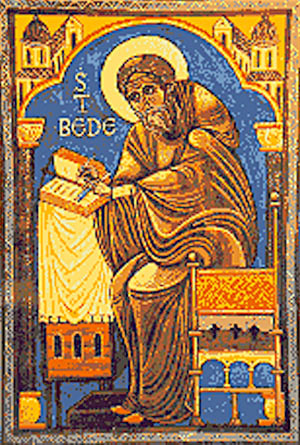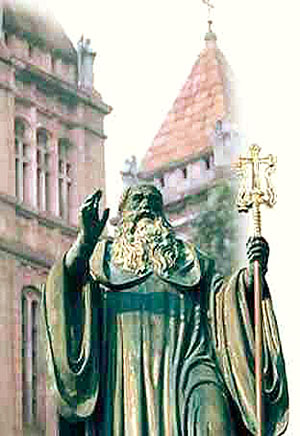 |
The Saint of the Day
St. Bede the Venerable, May 27
Prof. Plinio Corrêa de Oliveira
Biographical selection:

Venerable Bede
|
St. Bede is a confessor and doctor of the Church. He rivaled St. Isidore of Seville as one of the wisest and more illustrious men of his time. Because his great sanctity was widely recognized during his lifetime and he could not be called saint, he was known as Bede the Venerable. The name was conserved after his death and canonization. He was born in 672 at Jarrow, on the borders of England and Scotland, and died in 735.
Comments of Prof. Plinio:
Given that this selection is very short I will comment on the title of venerable conferred upon St. Bede. What does venerable mean? When can a person be said to be venerable?
First, venerable was a title of honor attributed by the Church to a person whose process of canonization was underway. The application of this title has varied through the centuries. For some time, a person whose process had been introduced was called venerable. Later, the Church replaced this with the title servant of God to refer to the first stage of the process of canonization.
The next levels of this process are beatification and canonization. The person was beatified and received the title of blessed after the Church had exhaustively examined his or her life and works and concluded that the person practiced the theological and cardinal virtues in a heroic degree. A first miracle was also required to be declared blessed. Since the beatification included a moral certainty that the person was in Heaven, the Church used to permit some kind of cult in the place where the person had lived or exerted influence, for instance his city or religious order.
The person was canonized and declared a saint, the last step, when new miracles, usually two in number, were verified. When they were confirmed by an exacting board of scholars, the person was canonized, i.e., he or she was declared saint and pointed to as a model for Catholics and presented for the cult of the universal Church.
Venerable was used, therefore, for one whose process had been introduced. In the good times – before Vatican II – when everything was serious, the word signified that the person was worthy of great consideration and respectability, in a word, worthy of veneration. It was already a great honor to have one’s name introduced for the process of canonization.
Second, in common usage, without any canonical implication, one can say that a person is venerable in many cases. Let me give some examples:
- A man or woman is called venerable when he or she has advanced in years and conserved the seriousness and dignity that this age requires. So, we venerate an 80-year-old man who always fulfilled his duties in the formation of his numerous family. To call him venerable means that his long and continuous practice of these virtues generates respect.
- A man who displayed heroic behavior in combat or a general who won many battles also deserves to be called venerable, because such men carried out valiant actions that deserve respect. In principle, anyone who risks his life for the Church or the State has realized an outstanding action and is venerable in this respect.
- Another example would be a religious woman who took care of lepers for a long period of time, running the imminent risk of being contaminated by the disease. We call her venerable for her long selfless service.
Therefore, in common usage, venerable is used for the person who has an extraordinary will, temper of spirit, and constancy that enabled him to exercise an upright behavior for a long period of time even in face of adverse circumstances and at the risk of his life, health, and comfort.

This stately statue of St. Benedict is a good example of venerability
|
This person inspires a special admiration in those who deal with him. They feel that justice demands that they pay him some tribute of respect.
This kind of respectability results from seriousness, strength and abnegation. To reach such a high level of fulfillment of his duties, the person must have been serious, strong and abnegated.
A good example of venerability can be found in the statue of St. Benedict that is placed in downtown São Paulo outside the grandiose Monastery of St. Benedict. The statue of St. Benedict stands outdoors looking at the city that stirs and passes at his feet. He is portrayed in his sixties or seventies with a great long beard and a shepherd’s staff in his hand. His person inspires meditation, profound thoughts, seriousness, and stability. He is the faithful image of the venerable patriarch.
Unfortunately, a large number of statues we have in our churches do not inspire veneration, due to either the sentimental style of such statues influenced by the Sulpician movement of the 19th century, or the modern style that was imposed everywhere after the Council. But we can still find venerable statues worthy of our admiration here and there.
How I would like to know St. Bede the Venerable personally! I imagine him wearing a long Benedictine habit, with a grave voice communicating wisdom. I picture him as a man grandiose as a cathedral. On my knees before this venerable man, I would like to ask for you and for me some of the venerability that he had, because without some kind of venerability, no one can be truly Catholic.


  | | Prof. Plinio Corrêa de Oliveira | |
The Saint of the Day features highlights from the lives of saints based on comments made by the late Prof. Plinio Corrêa de Oliveira. Following the example of St. John Bosco who used to make similar talks for the boys of his College, each evening it was Prof. Plinio’s custom to make a short commentary on the lives of the next day’s saint in a meeting for youth in order to encourage them in the practice of virtue and love for the Catholic Church. TIA thought that its readers could profit from these valuable commentaries.
The texts of both the biographical data and the comments come from personal notes taken by Atila S. Guimarães from 1964 to 1995. Given the fact that the source is a personal notebook, it is possible that at times the biographic notes transcribed here will not rigorously follow the original text read by Prof. Plinio. The commentaries have also been adapted and translated for TIA’s site.
|
Saint of the Day | Home | Books | CDs | Search | Contact Us | Donate

© 2002- Tradition in Action, Inc. All Rights Reserved
|
 |

|